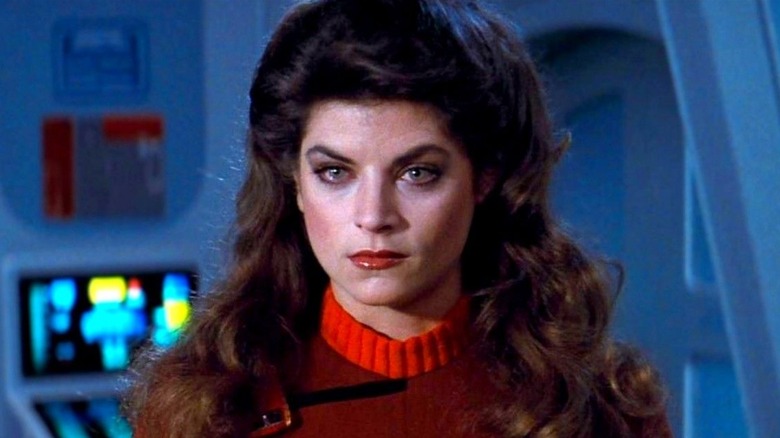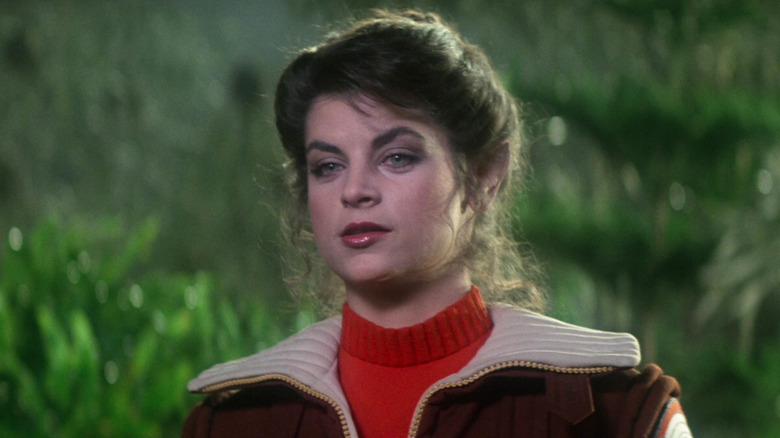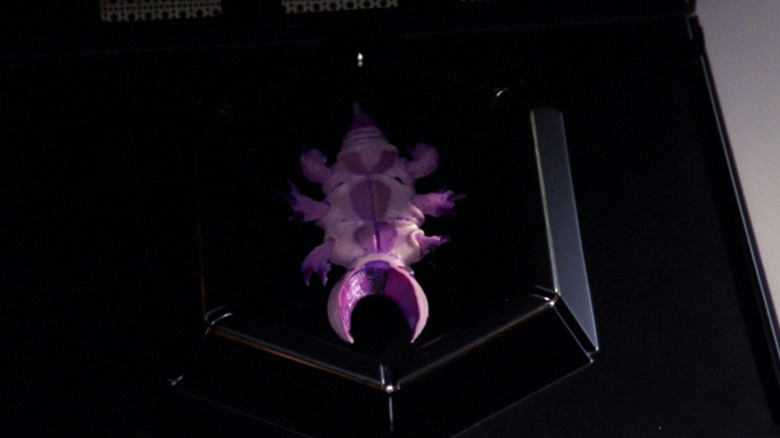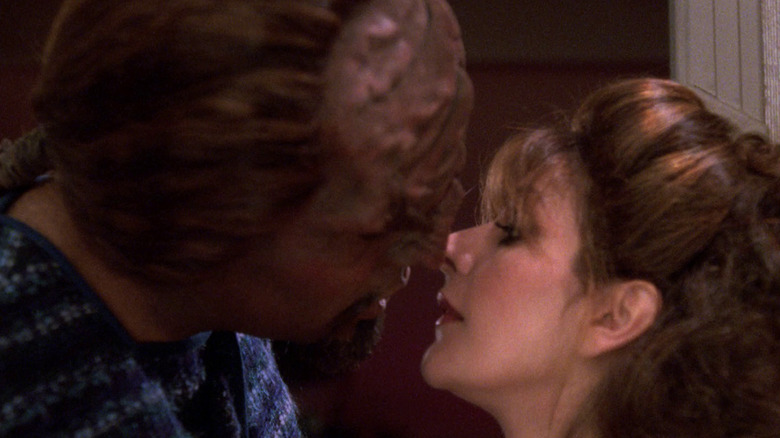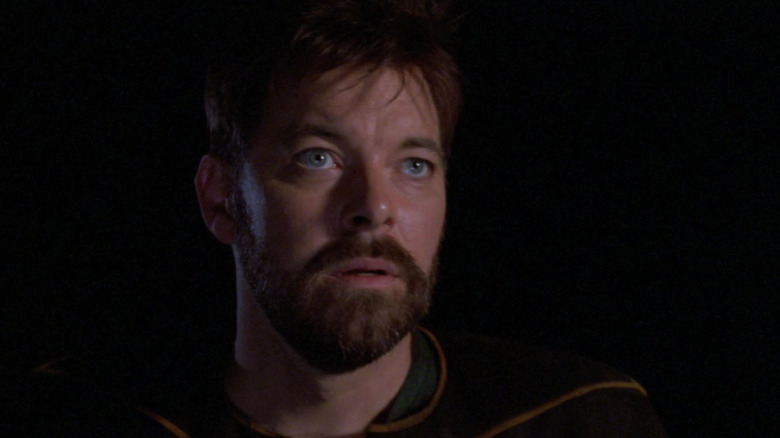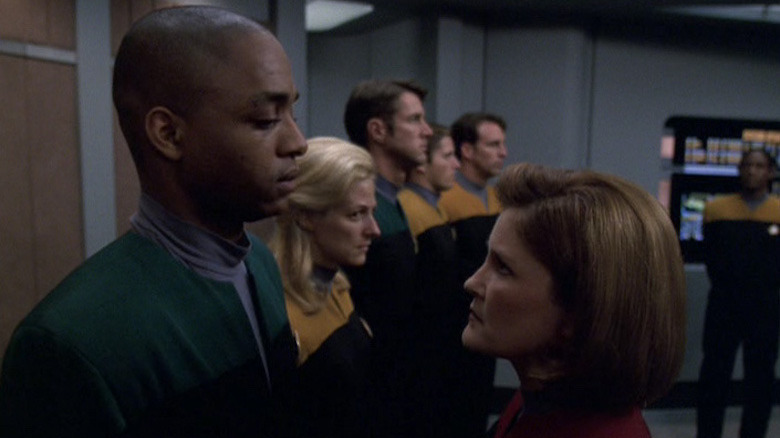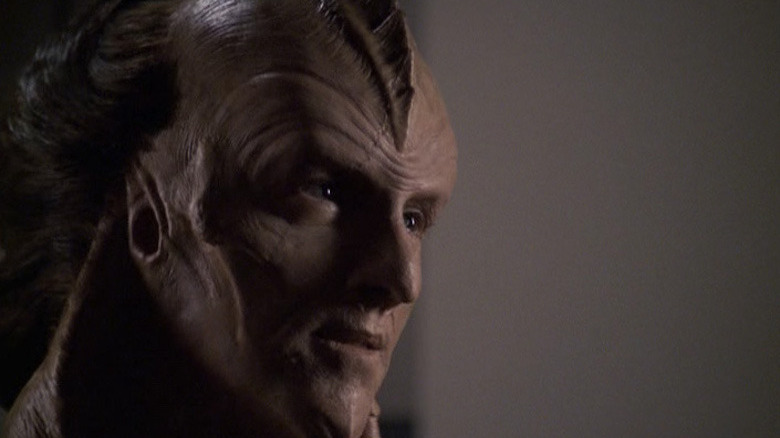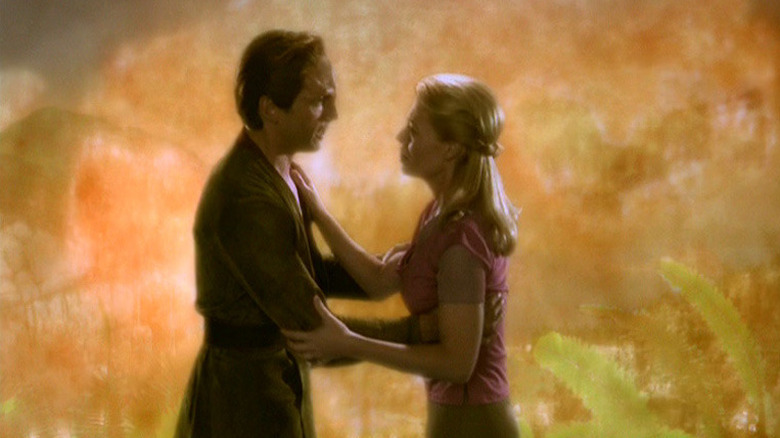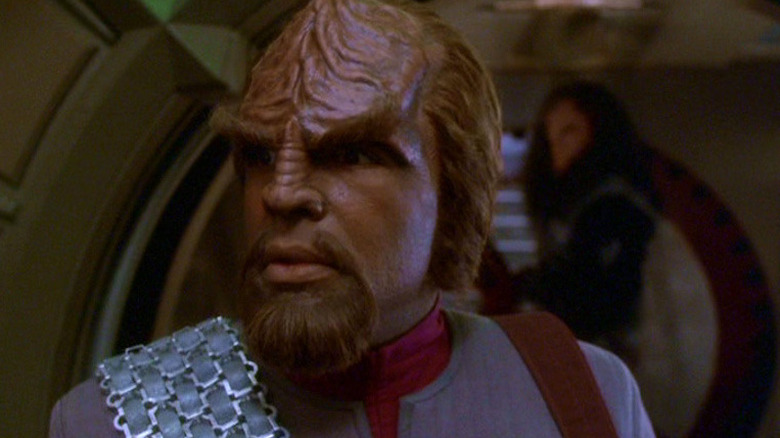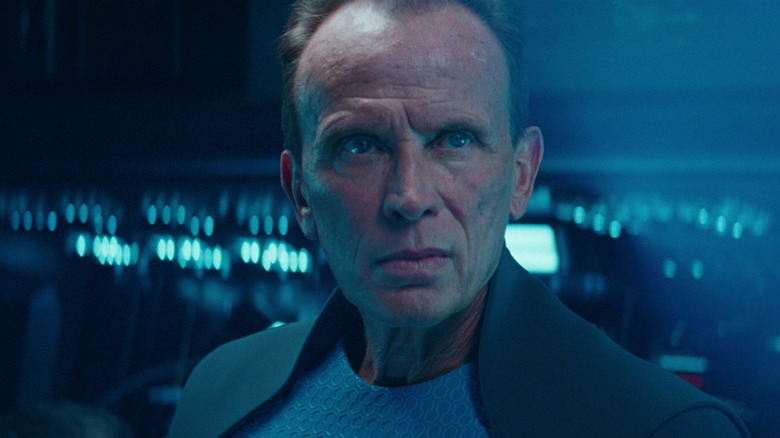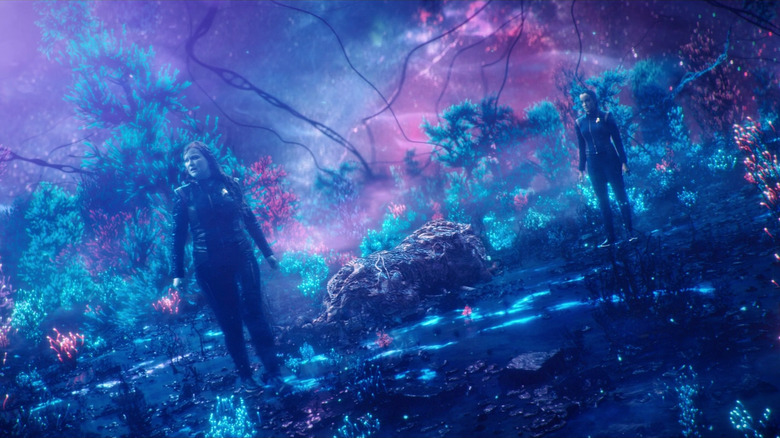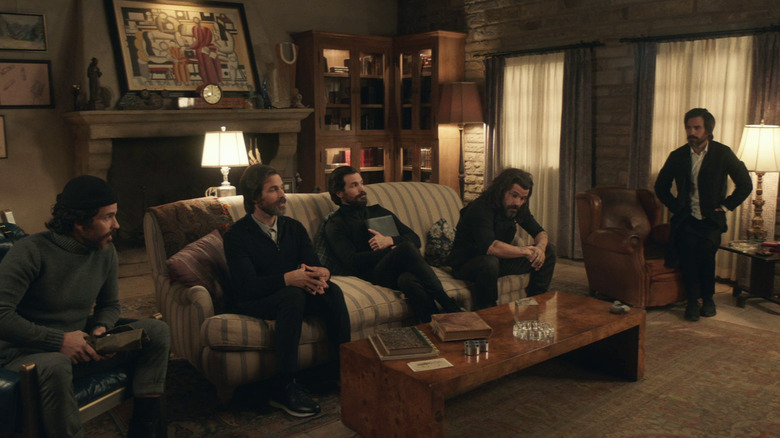Star Trek Storylines That Disappeared Without Explanation
When the original "Star Trek" series premiered in 1966, audiences didn't have much reason to expect long-running story arcs or a strict continuity from a television series. With very few exceptions, each episode of the original "Trek" introduces its own new alien cultures, planets, and guest stars whose stories are tied up neatly in about 50 minutes. Even major character developments like the death of a loved one or having your entire memory permanently erased by an evil space probe are totally forgotten in the next episode, and that was totally normal by the standards of 1960s television.
This had changed by the time "Star Trek" made the leap to the big screen in 1979 and returned to TV in 1986. Reruns and home video had made viewing audiences more sophisticated — they had a memory, now the stories had to as well. "Star Trek" as a whole (now consisting of over 800 episodes and films) has a pretty good track record of tying up loose ends, even when it's done sloppily. That doesn't mean there haven't been occasions when it feels as if the storytellers either forgot about a thread they'd left dangling or simply cut it off without comment. Here are a few of our favorite storylines from "Star Trek" — past and present — that seemed to have potential and then went nowhere.
Saavik was the future of Starfleet, until she wasn't
"Star Trek II: The Wrath of Khan" introduces Lt. Saavik, Spock's star pupil at Starfleet Academy. Saavik is a central character in "Khan," given significantly more screen time than Scotty, Uhura, Sulu, or Chekov — and it seems as if she's being set up to succeed Spock, who dies at the end of the film. In "Star Trek III: The Search for Spock," Saavik again has a prominent role as a member of the party that discovers the reconstituted Spock on the Genesis Planet. But in "Star Trek IV: The Voyage Home," Saavik has only a cameo, and she's left behind on Vulcan while the crew returns to Earth to face judgement for hijacking the Enterprise. Saavik is never referenced in the canon again.
While it didn't make it onto the screen, Saavik's disappearance actually did originally come with an explanation. A scene deleted from "Star Trek IV" would have explained that Saavik became pregnant from her sexual encounter with Spock on the Genesis Planet, and remained on Vulcan for her maternity leave. This would have provided Saavik a clear avenue to return in future stories, but instead, her journey simply ends.
Later, when creating the story for "Star Trek VI: The Undiscovered Country," screenwriters Nicholas Meyer and Denny Martin Flynn wanted to bring back Saavik, but only if original actress Kirstie Alley was available to portray her. In Alley's absence, the new character of Lt. Valeris was created instead.
The missing parasites
In "Coming of Age," a 1st season episode of "The Next Generation," the crew of the USS Enterprise comes under scrutiny from Starfleet Admiral Gregory Quinn, who believes that there is some sort of trouble brewing in Starfleet but will not elaborate. The Enterprise crew passes this inspection with flying colors, but still isn't privy to the nature of the investigation. The truth is revealed a few weeks later in "Conspiracy," when Picard and company encounter a sinister, unnamed race of parasites that has infiltrated the ranks of Starfleet by bodyjacking high-ranking officers — and they now have Admiral Quinn under their thrall. The Enterprise exposes the parasites' plot and (in an uncharacteristic display of brutality) kills their hive mother, but the episode ends with the ominous sound of a homing signal being sent into deep space, implying that the parasites would be returning.
This was not to be — the parasites never reared their ugly heads again. According to the official reference book "The Star Trek Chronology," the parasites were meant to tie in to the introduction of the Borg, who were originally envisioned as an insectoid race. It stands to reason that once the Borg were re-imagined as cyborgs, the connection was dropped. While the parasites were never referenced again, "Star Trek: Deep Space Nine" would have its own, more developed plotline centered around malevolent aliens infiltrating Starfleet as part of its years-long Dominion War arc.
Deanna and Worf broke up off-screen
In the 5th season "Next Generation" episode "New Ground," Lt. Worf takes custody of his young son, Alexander, and struggles to adjust to life as a single parent. This storyline runs through the rest of the series, and gives him cause to interact with another member of the ensemble with whom he has little in common — Counselor Deanna Troi. Worf frequently seeks Troi's advice in handling his new responsibilities and his son's expectations. Their professional relationship grows into a friendship and, eventually, a romance. By the end of the series finale, "All Good Things...", they seem to be firmly established as a couple, the result of years of legwork by the storytellers.
So it's surprising that, after "All Good Things...", the Deanna/Worf relationship is totally forgotten. The next appearance for both characters is the film "Star Trek: Generations," during which they share no significant interaction. After this, Worf becomes a regular on "Deep Space Nine" where he apparently arrives unattached. He begins a romance with Jadzia Dax while Deanna rekindles her prior relationship with Will Riker in the "Next Generation" film series. While both final pairings are admittedly more satisfying, it's bizarre that Deanna and Worf's relationship is simply dismissed offscreen, leaving their breakup to be explored in the non-canonical novel "Triangle: Imzadi II."
Thomas Riker is still rotting in prison
Introduced in the "Next Generation" episode "Second Chances," the man who would eventually call himself Tom Riker is a transporter duplicate of Commander William Riker. Tom is created years before "The Next Generation" even begins, when the crew of the USS Potemkin beams up a then-Lieutenant Riker, not realizing that their transporter beam has been split and a copy has been marooned on a deserted planet. This Riker spends eight years totally alone before he is discovered by the crew of the Enterprise and learns that another Riker has been living out his life.
In the "Deep Space Nine" episode "Defiant," Thomas poses as his "twin" in order to steal the advanced Starfleet warship USS Defiant for the Maquis, a rogue organization fighting a desperate guerrilla war against the occupying Cardassian Union. At the end of the episode, Thomas is forced to surrender to the Cardassians in order to save his crew, and sentenced to life in a labor camp. Major Kira Nerys, a former resistance fighter herself, swears to Thomas that he'll be rescued. This rescue never comes, at least not on screen, and this is the last time Thomas Riker is ever mentioned in any canonical "Star Trek" work. It's surprising that this story never got wrapped up, considering how eager actor Jonathan Frakes is to participate in all things "Trek." (He's appeared as Riker on six different series.)
The Equinox crew disappears
In the "Star Trek: Voyager" two-parter "Equinox," the Voyager crew encounters the USS Equinox, another Federation starship that's been lost in the Delta Quadrant for five years. Unlike Voyager, Equinox is in terrible shape due to lacking the magical "reset button" that restores Voyager to perfect condition after the end credits of every episode. In order to accelerate their journey home, the Equinox crew resorts to hunting sentient extra-dimensional beings and using their bodies for fuel, becoming mass murderers in the process.
At the end of the "Equinox" two-parter, Equinox is destroyed, leaving only five survivors aboard Voyager — two of whom had been featured characters throughout this story. This remainder of the Equinox crew, who followed unconscionable orders and participated in an attempt to destroy Voyager, are integrated into the Voyager crew. They are stripped of rank and put under constant surveillance. Captain Janeway tells the survivors that they'll have to work to earn her trust, but they never get that chance. The Equinox survivors are never seen or spoken of again.
Like the integration of the Starfleet and Maquis crew at the start of the series, the introduction of the Equinox refugees could have been the source of some interesting conflict in future stories. The Maquis subplot ran its course over about two seasons, but the Equinox and its survivors were forgotten immediately, ironically becoming one of the most prominent casualties of the "Voyager" reset button.
The Vaadwaur had no teeth after all
In the "Voyager" episode "Dragon's Teeth," the crew discovers six hundred humanoids who have been in preserved in suspended animation for nine centuries, and Seven of Nine decides to revive them. This culture, the Vaadwaur, turn out to be a colonizing empire who once controlled a significant portion of the Delta Quadrant. This was accomplished via their mastery of a secret method of high-warp travel called the Underspace Cooridor. The Vaadwaur were forced into stasis by a resistance movement comprised of species from their occupied territories, after which they faded into myth.
By waking up the Vaadwaur, Voyager unwittingly unleashes a deadly threat upon the galaxy, one determined to reclaim and expand their territory and destroy or exploit anyone in their way. While they survive this first encounter, the episode ends with Seven and Captain Janeway pondering the greater implications of Seven's act of compassion, certain that they would be butting heads with the Vaadwaur again. And yet, apart from one of their ships being sighted in a potpourri group of vessels in an unrelated episode, there's no trace of the Vaadwaur for the rest of the series.
This was a serious missed opportunity for "Voyager." The nature of the protagonists' one-way journey through the galaxy made it difficult to justify recurring antagonists, leading to an over-reliance on the Borg. The Vaadwaur were a cool, fresh new villain who could easily have returned at any time, and never did.
The Borg insurgency apparently made no impact
In the two-part "Voyager" episode "Unimatrix Zero," Seven of Nine discovers that there is a secret resistance movement building inside the Borg Collective. A quirk in the Borg's collective consciousness has allowed a small percentage of drones to commune with each other in a shared dreamspace while they recharge. On this plane, which they call Unimatrix Zero, they regain their original personalities and retain memories from previous visits. With some help from Voyager, these individual Borg are able to break free from the collective and function as free individuals, even commandeering a few Borg ships to take up arms against the Queen.
Though Unimatrix Zero itself is destroyed, the story ends with the news that a few of the liberated Borg ships are banding together to create an organized resistance movement, and that they would remain in touch with Voyager. A new wrinkle in the ongoing battle with the series' biggest bad would seem worthy of revisiting — but this development is never mentioned again, not even in the two-hour final episode that features Voyager's ultimate confrontation with the Borg Queen.
"Unimatrix Zero" also introduces Axum, a fellow Borg with whom Seven has developed a romantic relationship inside the shared dreamspace. Before the collapse of Unimatrix Zero, Axum makes a promise to Seven — "I'll find you." While the episode acknowledges how improbable their reunion would be, it still would have been less ridiculous than pairing her up with Chakotay at the last minute.
Ambassador Worf had a very brief tenure
In the series finale of "Star Trek: Deep Space Nine," "What We Leave Behind," much of the crew of the titular space station moves on to other assignments. This includes Lt. Commander Worf, who has been serving as DS9's Strategic Operations Officer. At the close of the series, Worf accepts an invitation to become the Federation's new ambassador to the Klingon Empire, now ruled by his close friend Martok. This is the completion of Worf's arc across 11 seasons and two television series, returning to Qo'nos after a lifetime of isolation from his people but doing so while still serving his adopted home in the Federation. He's spent his life split between two worlds, and now he can finally be a part of both.
Then came "Star Trek: Nemesis," the last feature in the "Next Generation" film series. Here, Worf has returned to his old post as chief security and tactical officer aboard the USS Enterprise with zero explanation whatsoever. This is particularly bizarre given how easily Worf's presence in "Nemesis" could have been explained — after all, the film opens with the wedding of two of his closest friends on the Enterprise's holodeck. Instead, he's just back in Starfleet, no further information offered. Like Worf's relationship with Troi, this dropped thread had to be explained retroactively in "Star Trek" novels, which depict Worf deciding that he does not have the temperament for diplomacy and resuming his Starfleet career where he left off.
Admiral Marcus starts a war we never see
In "Star Trek Into Darkness," the second film in the rebooted "Kelvinverse" trilogy, militaristic Starfleet Admiral Alexander Marcus thaws out cryogenically-frozen genetic superman Khan Noonian Singh to help him develop the next generation of weapons and tactics. Marcus' stated motivation is to prepare the Federation for a war with the Klingons that he is certain is coming. Marcus plans to provoke the war on his own terms by sending the USS Enterprise to launch a first strike against the Klingon Homeworld. While this operation doesn't go exactly how Marcus expected, he's still certain that war with the Klingons is inevitable and that the Federation will be doomed if the likes of Captain Kirk are left in command.
The next film in the series, however, does not follow up on this thread at all. "Star Trek Beyond" is instead a more lighthearted standalone story (and a much better movie), but since no further installments of the Kelvinverse film series have yet been produced, the fallout from "Into Darkness" has never been explored. Granted, "Star Trek Into Darkness" is probably best forgotten altogether, and now that we've seen the Prime Universe's version of the Klingon/Federation conflict of the 2250s on "Star Trek: Discovery" (which was triggered by an entirely different set of events), there's not much excitement left in the prospect of seeing its Kelvinverse counterpart. Not every abandoned storyline is a tragedy — sometimes we're better off without.
The Spore Drive's environmental impact was immediately forgotten
In the "Star Trek: Discovery" episode "An Obol for Charon," Ensign Tilly's body is inhabited by a jahSepp, a being from the mycelial realm through which USS Discovery travels using their experimental Spore Drive. The being, who has taken the form of Tilly's childhood friend May, tells Lt. Stamets that Discovery's jumps through the mycelial network have been devastating their ecosystem. Stamets, a staunch environmentalist, is prepared to shut down the project immediately, but before he does so, May abducts Tilly into the mycelial realm. In the next episode, "Saints of Imperfection," May reveals that she's brought Tilly into her world to hunt a "monster." This turns out to be Stamets' presumed-dead partner Dr. Hugh Culber, who is unwittingly damaging their habitat by his presence. When Culber is returned to normal space, this appears to satisfy May's concerns about her environment, but it doesn't seem as if it should.
When May first explains the damage to Stamets, she says it's been caused by "an alien intruder [who] began to arrive at random intervals," which perfectly describes the way Discovery uses its Spore Hub drive to travel through mycelial space. Culber, on the other hand, arrives in the jahSepp's realm upon his death, and then remains until his rescue — nothing random about it. "Saints of Imperfection" seems to toss out the idea of the Spore Drive as an environmental hazard without so much as a line of dialogue to explain it away.
Photons Be Free! (Or don't?)
One of the running threads across all seven seasons of "Star Trek: Voyager" is the gradual evolution of the ship's Emergency Medical Hologram (or EMH, but usually just called "The Doctor") from a tool designed for short-term emergency use to a fully sentient being. Late in the series, The Doctor learns that other copies of his program, with the same potential for personhood, have been retired from service as physicians and forced into a life of manual labor. This inspires him to compose the semi-autobiographical political holonovel "Photons Be Free," whose publication becomes the first small step in establishing legal rights of personhood for sentient holograms.
The wheels of justice turn slowly and the parameters for holographic life are still sketchy at the end of "Voyager," but even by the time of "Star Trek: Picard," set 21 years later, nothing about the relationship between holograms and organic sentients appears to have changed. Holograms such as La Sirena's own EMH and other holographic crew supplements are still interactive programs with personalities, quirks, and preferences — and they still appear to be property. It's possible that these programs are deliberately limited in scope and potential as to avoid true sentience, thus remaining tools and skirting the issue of their rights. But given that "Picard's" first season is so preoccupied with the rights of physical artificial lifeforms, it's a bit strange that the implications on photonic life are ignored. Perhaps future seasons (or series) will explore this further.
